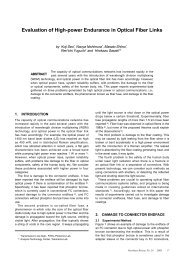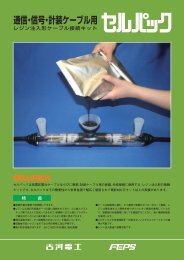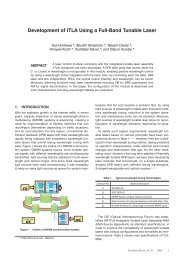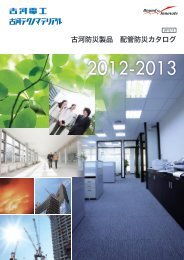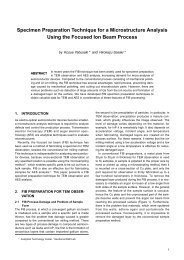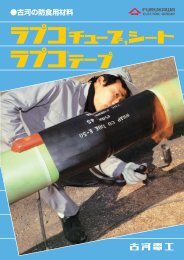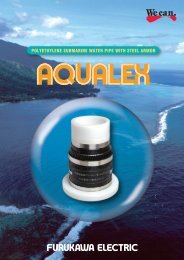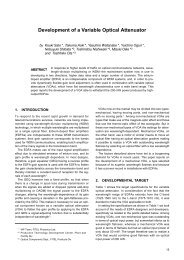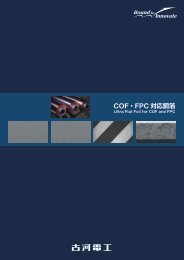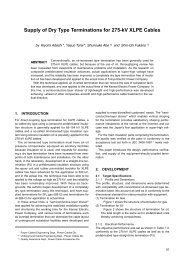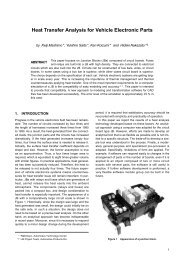Underground Power Cable, Distribution Cable, Overhead
Underground Power Cable, Distribution Cable, Overhead
Underground Power Cable, Distribution Cable, Overhead
You also want an ePaper? Increase the reach of your titles
YUMPU automatically turns print PDFs into web optimized ePapers that Google loves.
<strong>Underground</strong> <strong>Power</strong> <strong>Cable</strong>, <strong>Distribution</strong> <strong>Cable</strong>, <strong>Overhead</strong> Transmission Line, Industrial <strong>Cable</strong> and Their Accessories<br />
6. ACCESSORIES FOR OVERHEAD<br />
TRANSMISSION LINES<br />
6.1 Oscillation Analysis Technology<br />
We have been carrying out observations of an oscillation<br />
phenomenon called galloping ever since we constructed<br />
the Mogami Test Line (see Figure 33) in Shonai-machi,<br />
Higashi-tagawa-gun, Yamagata prefecture. Galloping is<br />
one of the peculiar aerodynamic phenomena seen in winter<br />
seasons, where more specifically, overhead conductors<br />
with snow or ice accretion oscillate in large amplitudes<br />
in the vertical plane when the wind speed and wind<br />
velocity meet certain conditions.<br />
Because, if the oscillation amplitude increases, it is possible<br />
that the conductors will come into contact with each<br />
other thereby causing short circuit accidents, clarifying its<br />
mechanism in an effort to prevent accidents is a very<br />
important task for appropriate maintenance of electric<br />
power facilities. Accordingly we have been addressing<br />
this problem since 1979.<br />
The vicinity of Shonai-machi is provided with suitable<br />
conditions for occurrence of galloping due to the local<br />
wind called “Kiyokawa-dashi” that blows almost throughout<br />
the year. Because snow accretion is the absolute condition<br />
for occurrence of galloping, we use a “mock accreted<br />
snow” (see Figure 34) that can achieve equivalent<br />
Figure 33 Panoramic view of Mogami Test Line.<br />
Figure 34 Installed “mock accreted snow” to simulate snow<br />
accretion.<br />
effects during snowless seasons to forcibly generate galloping.<br />
This test line is characterized by its unattended observation<br />
operation using our proprietarily developed system,<br />
in which measurement data such as wind direction,<br />
wind velocity, conductor tension and conductor displacement<br />
are transferred in real time to our laboratory located<br />
in Nagai-city. The obtained data are input to simulation<br />
software to achieve comparative analysis between the<br />
actual measurements and the simulated results, enabling<br />
improvement of simulation technologies as well as application<br />
to development of countermeasure products. Our<br />
“loose spacer damper” that has received a lot of inquiries<br />
from electric power companies is one of the representative<br />
examples (see Figure 35).<br />
Airflow simulation software has also been introduced<br />
since last year, which predicts wind behavior at any location<br />
with specific geographical features when the longitude<br />
and latitude of that place are given. Combining this<br />
software with the one for oscillation analysis will enable<br />
improving the accuracy of oscillation analysis as well as<br />
simulating wind behavior at an arbitrary spot on a power<br />
transmission line. Since these techniques, together with<br />
the mechanical deterioration data such as fatigue degree<br />
and wear amount that have long been accumulated,<br />
make it possible to predict the progression of products<br />
deterioration, it is expected that they will lead to creation<br />
of a new customer service like making suggestions for<br />
replacement life time of products.<br />
6.2 Deterioration Prediction Technology<br />
The causes of deterioration of overhead conductors may<br />
be divided into two categories: one is mechanical deterioration<br />
which is caused by loads due to oscillation and the<br />
like, and the other is electrical deterioration in which electrical<br />
resistance increases at electrical connections under<br />
application of current. While we are involved with both of<br />
Figure 35 “Loose spacer damper” for four-conductor overhead<br />
transmission lines.<br />
Furukawa Review, No. 32 2007 1





